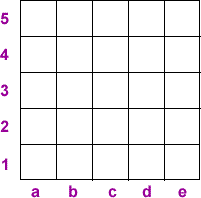Copyright © University of Cambridge. All rights reserved.
'A Square Deal' printed from https://nrich.maths.org/
A Square Deal
Complete the magic square using the numbers $1$ to $25$ once each.
Each row, column and diagonal adds up to $65$.
Each square is identified by its column and row:

Here are the clues:
Perfect squares are in b5, b3, d3, b1 and c1.
Prime numbers are in a5, c5, e5, c4, a3, c3, e3, e2 and a1.
Triangular numbers are in d5, e4, d3, a1, e1 and c2.
Perfect cubes are in d3 and b2.
Powers of 2 are in b5, b2, e2 and b1.
Palindromic numbers are in a5 and d1.
Factors of 100 are in b5, d5, c4, b3, d3, a2 and e2.
The median of all the numbers is in c3.
Row 3 and column c are all odd.
Numbers that are the same upside-down are in a5, d3 and b2.
This problem is taken from the summer 2003 edition of "Mathematical Pie", a booklet of mathematical challenges published three times a year by The Mathematical Association. For more details about how to subscribe, see the MA website or phone 0116 221 0013.
Why do this problem?
This problem encourages a systematic approach and it will familiarise children with number properties.
Key questions
How could you start this problem?
Why not list the square numbers/cube numbers etc?
How could you work out the median?
How about looking for squares that are listed in more that one clue to get you started?
Possible extension
The problem
Two and Two also requires learners to work very systematically and might be a good next step.
Possible support
The
hints suggest some good starting points. Working with a partner will help many children have a go at this problem.
